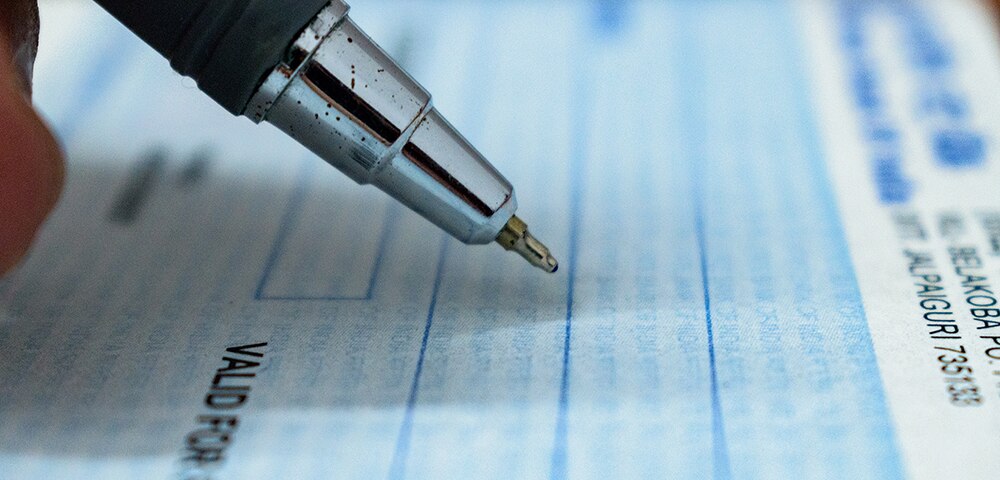Check fraud is back in business. Here’s how to keep it from impacting yours.

Imagine the following scenario: While reconciling your business accounts at the end of a busy day, a member of your finance team notices something unusual about a posted check. What should have been a payment of $250 to a regular vendor has posted as a payment of $8,800 to a recipient whose name you don’t recognize.
If something like this has ever happened to your business, you’ve been a victim of check fraud — and you’re not alone.
Reports of check fraud have continued to rise in recent years
Check fraud is not a new phenomenon. The crime of stealing or counterfeiting paper checks to access funds directly from a victim’s bank account has been going on for decades. But recently, new techniques like check washing, organized criminal rings, and post office vulnerabilities have driven a major increase in reports of check fraud.
The Financial Crimes Enforcement Network (FinCEN), a division of the U.S. Treasury Department, issued an alert in February of 2023, warning financial institutions of a “nationwide surge in check fraud schemes targeting the U.S. Mail.”1 According to FinCEN, financial institutions filed more than 350,000 reports of potential check fraud in 2021 — a 23% increase from 2020. In 2022, the number of filings nearly doubled to 680,000.
In September 2024, FinCEN released a trend analysis report examining the number of mail theft-related check fraud incidents filed in the six months following its 2023 alert. According to the report, during the review period alone, FinCEN received 15,417 reports from 841 financial institutions on mail theft-related check fraud, amounting to more than $688 million in reported suspicious activity.2
Recent research from the Association of Financial Professionals indicates that checks continue to be the payment method most vulnerable to fraud. 65% of financial professionals surveyed reported that their organizations faced some kind of check fraud activity in 2023.3
Old tricks, new tools
The most common form of check fraud is check washing: Perpetrators use common solvents found in nail polish remover or household cleaning products to alter the recipient name and the amount on the face of the check, then deposit or cash it using a fraudulent identity. Fraudsters may also scrape the ink off a stolen check or use tape to lift off printed characters. This kind of crime is so prevalent that detailed instructions for how to wash checks can be found on social media platforms, including TikTok.
Recently, organized check fraud crime rings have also emerged. Sophisticated criminals use messaging apps like Telegram, which allow them to send encrypted messages and conceal their identities, to recruit and train individuals and execute check fraud schemes. These perpetrators steal checks from USPS mailboxes, frequently targeting the “blue boxes” located in cities and neighborhoods all over the country.
More brazen criminals have been known to threaten and rob individual mail carriers, and some have stolen entire mail trucks in search of checks to wash.
Three ways to protect your business
Unfortunately, every business is a potential target for check fraud — and the softest targets are the ones most likely to be hit. Thieves are looking for the path of least resistance, so the more lax your security standards, the more susceptible your organization will be to all kinds of fraud.
While it’s impossible to prevent all possible fraud, Key’s Payments specialists recommend these three steps to reduce your company’s risk:
- Reduce check use. The best way to prevent check fraud is to reduce or eliminate payments by paper check. In addition to helping businesses avoid fraud, digital payment platforms can help lower the cost of paying vendors and suppliers.
- Use available tools that catch fraud. Banks offer a range of tools to mitigate the risk of check fraud. For example, Key’s Positive Pay service provides fraud detection reporting by comparing items presented for payment against the check details provided in your issuance file. Any checks that do not match are presented to you for review and payment disposition (pay/no-pay decisions). These tools are already widely in use by large businesses that issue thousands of payments every week. But with check fraud on the rise, businesses of all shapes and sizes need to strengthen their internal controls.
- Daily reconciliation. Last but not least, if you must issue paper checks, make sure to reconcile your business accounts every day and immediately report any suspicious or obviously fraudulent activity to your bank. Additionally, businesses should implement a tightly controlled check-printing process, and limit employee access to check stock. Finally, with check theft via the USPS on the rise, avoid sending checks through the mail unless absolutely necessary.
The recent resurgence in check fraud is a powerful reminder that even the most basic criminal schemes can pose a significant threat to businesses. If you suspect that a fraudulent check from your business has posted, it’s critical to notify your bank immediately. To learn more about mitigating payments fraud, including check fraud, please review Meeting Fraud Threats With Security Solutions.
Content provided for informational and educational purposes only and is in no way to be construed as financial, investment, or legal advice. We cannot and do not guarantee their applicability or accuracy in regards to your individual circumstances. All examples are hypothetical and are for illustrative purposes. We encourage you to seek personalized advice from qualified professionals regarding all personal financial issues.